Buddhism In Ancient Egypt And Meroe – Beliefs Revealed Through Ancient Script
Posted on August 9th, 2016
Courtesy comerjet.com
Published On: Fri, Aug 5th, 2016
බුදුදහමේ අතීතය ඊජිප්තු පිරමීඩ ඉතිහාසය දක්වා විසිර ඇති බව සොයාගැනේ..!!!
ෆ්ලින්ඩර්ස් නම් ඊජිප්තු ඉතිහාසඥයා මේ බැව් සාක්ෂි සහිතව පෙන්වා දී ඇත.අශෝක අධිරාජයාගේ ධර්ම දුත කණ්ඩායම් ලොව සිව් දෙස බුදුදහම විකාශණය කරමින් ගිය බැව් පිළිබඳව සාක්ෂි හමුවී ඇත.මේ ලිපිය බලන්න…
Did Buddhism exist in Upper Egypt and the Lower Meroitic Empire? The answer appears to be yes. It was in Memphis that English Egyptologist and archaeologist W. M. Flinders Petrie found evidence of Buddhist colony.
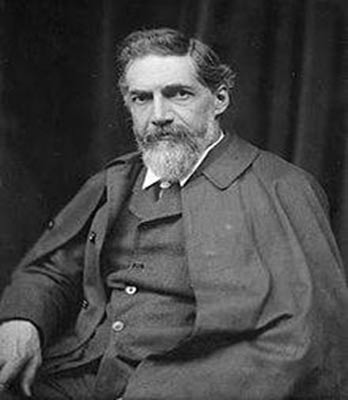 The Buddhist Colony
The Buddhist Colony
Flinders Petrie claimed these Buddhists dated back to the Persian period of Egypt (circa 525-405 BC). He wrote:
on the right side, at the top is the Tibetan Mongolian, below that the Aryan woman of the Punjab, and at the base a seated figure in Indian attitude with the scarf over the left shoulder. These are the first remains of Indians known on the Mediterranean. Hitherto there have been no material evidences for that connection which is stated to have existed, both by embassies from Egypt and Syria to India, and by the great Buddhist mission sent by Ashoka as far west as Greece and Cyrene. We seem now to have touched the Indian colony in Memphis, and we may hope for more light on that connection which seems to have been so momentous for Western thought”.
If Petrie’s dating is correct this puts Buddhists in Egypt two hundred years before Ashoka sent Buddhist missionaries to Egypt.
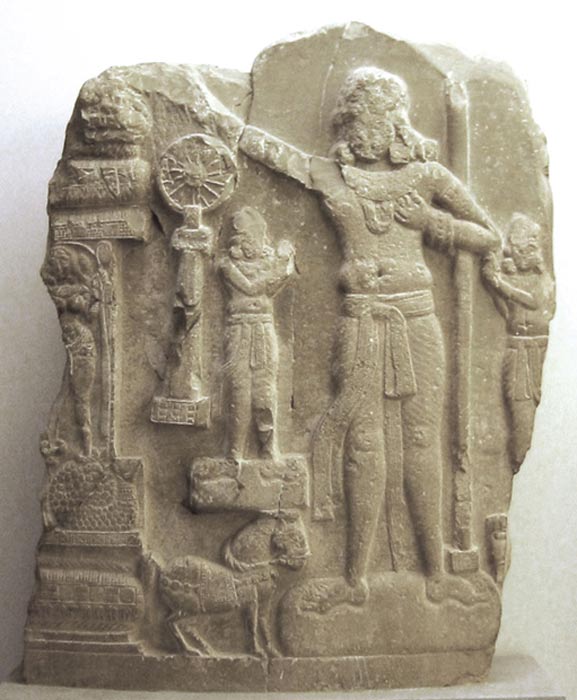 A circa 1st century BCE/CE relief from Amaravati, Andhra Pradesh (India). The figure in the center may represent Ashoka. ( CC BY-SA 3.0)
A circa 1st century BCE/CE relief from Amaravati, Andhra Pradesh (India). The figure in the center may represent Ashoka. ( CC BY-SA 3.0)
Ashoka was a king of India who worshipped Buddhism. Ashoka sent out edicts throughout his empire encouraging people to adopt Buddhism as a way of life written in various languages.
Ashoka Rock Inscription
Ashoka built a temple at Sarnath, which is called Lion Capital of Ashoka . In Buddhism lions represent the bodhisattvas, the sons of the Buddha”. The bodhisattvas are beings who have attained a high degree of spiritual development.
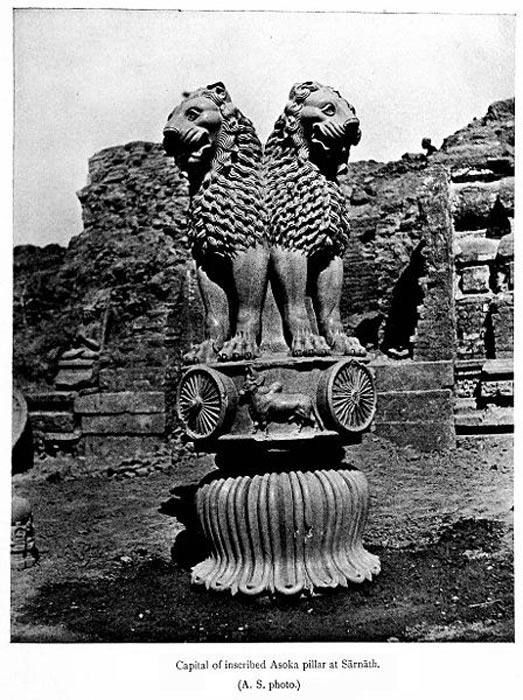
Ashoka lions at Sarnath, 1911.
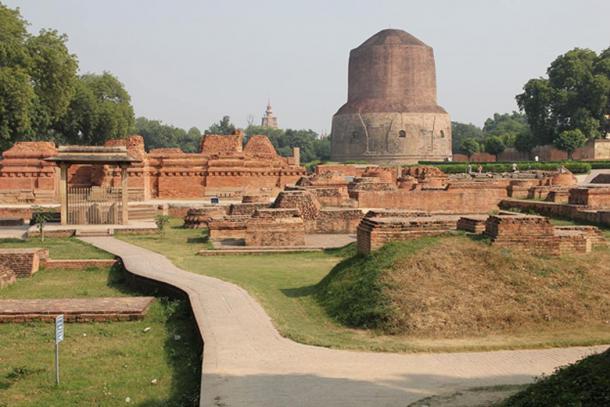 Monastery around Dhamek stupa, Sarnath. ( CC BY 2.0 )
Monastery around Dhamek stupa, Sarnath. ( CC BY 2.0 )
In Philostratus: The Life of Apollonius of Tyana it is made clear that the Gymnosophist lived in Upper Egypt and the Meroitic Empire. The Gymnosophists were Buddhists. The historical evidence makes it clear that there were probably two migrations of Buddhist Gymnosophists to Egypt and the Meroitic Empire.
Ashoka was a supporter of Buddhism. Zacharias P. Thundy, in Buddha and Christ makes it clear that the edits of Ashoka (circa 274-236 BC) indicate that this ruler sent missionaries to Egypt to preach the Buddhist Dharma.
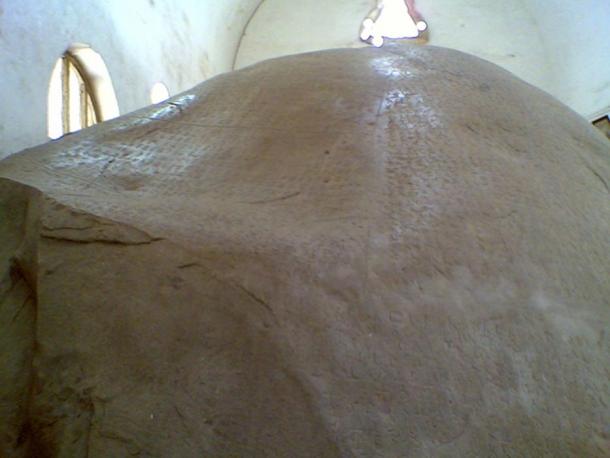 Ashoka’s Major Rock Edict at Junagadh contains inscriptions by Ashoka (fourteen of the Edicts of Ashoka), Rudradamanna I and Skandagupta. ( CC BY-SA 3.0 )
Ashoka’s Major Rock Edict at Junagadh contains inscriptions by Ashoka (fourteen of the Edicts of Ashoka), Rudradamanna I and Skandagupta. ( CC BY-SA 3.0 )
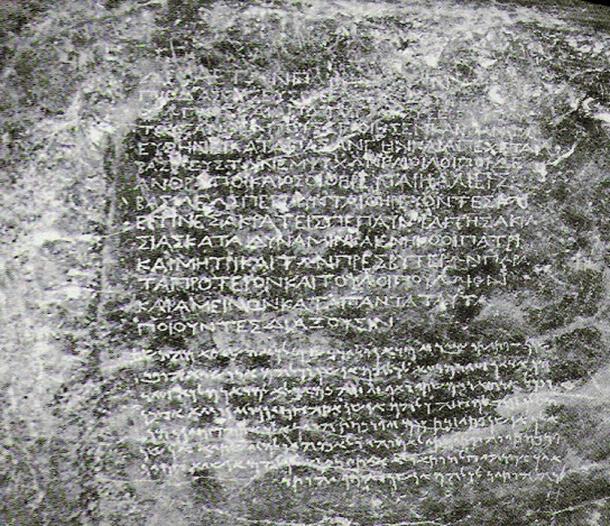 Bilingual inscription (Greek and Aramaic) by king Ashoka, from Kandahar. ( Public Domain )
Bilingual inscription (Greek and Aramaic) by king Ashoka, from Kandahar. ( Public Domain )
Thundy maintains that archaeological evidence exist for a community of Indian sages living in Memphis as early as 200 BC. We know that descendants of these missionaries were still in Egypt over two hundred years later because they were visited by Apollonius of Tyana.
Ashoka used the ancient script Kharosthi to write his edicts. The Buddhist also used this writing system to record their scriptures. This means that the Gymnosophists would have had a long tradition of employing Kharosthi to communicate their ideas. The Gymnosophists were probably well respected by the Meroites and some Meroites probably had knowledge of Buddhist teachings and literacy.
The Appearance of Blemmyae
Some Meroites may have played an important role in Buddhism because Blemmyae, a prominent group in the Meroitic Sudan are mentioned in Pali text Tipitaka.
Dr. Derrett wrote that in the early Pali text we have a Blemmya (an African) in front rank Buddhist texts of very respectable age. The Buddhist text where Blemmya were mentioned are very old. The Vinaya Pitaka , is dated to the fourth century BCE.
If Blemmya are mentioned in Buddhists text, we can be sure that Meroites (ancient kingdom of Kush) were not ignorant of Kharosthi. This would explain why many of the Meroitic symbols agree with Kharosthi. They agree because some Meroites were probably already literate in Kharosthi due to the influence of Buddhism in the Meroitic Empire.
There seems to have been a second migration of Buddhists to the Meroitic Empire many years after Ashoka sent missionaries to Egypt. These migrants came to the Meroitic Empire after their king was murdered.
Gymnosophists spread Buddhism in the Nile Valley
Flavius Philostratus, the writer of the Vita Apollonii , Vol.1, claimed that the Gymnosophists of Meroe originally came from India. The fact that the Kushana had formerly ruled India around the time that the Meroitic writing was introduced to the Kushite civilization, led to the hypothesis that the ancestors of the Gymnosophist may have been Kushana philosophers. The historical evidence of the Kushana having ruled India made the Classical references to Indians, the Gymnosophists in Meroe, an important source for the construction of alternative theories about the possible location of the cognate language of Meroitic.
Buddhism in Ancient Egypt and Meroe – Beliefs Revealed Through Ancient Script